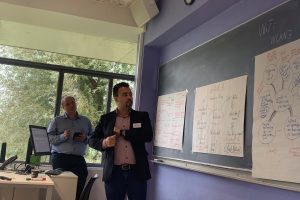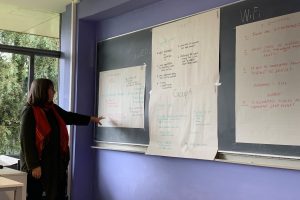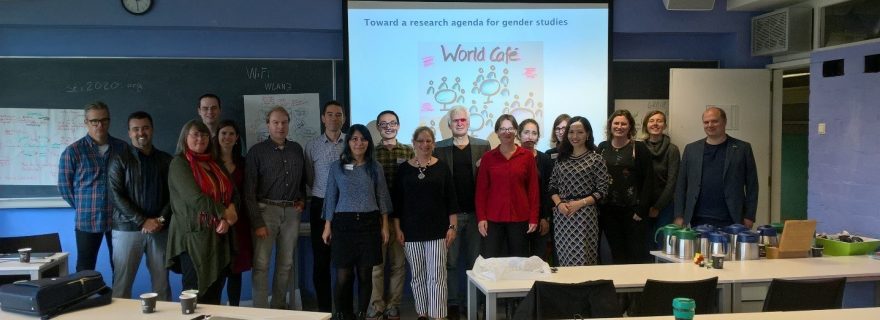Gender inequalities in science: Evidence and ideas from bibliometrics
Leiden University hosted the Gender Inequalities in Science workshop in October 2019 - organized by CWTS and Elsevier’s International Center for the Study of Research - where researchers from around the world discussed the gender gap in science and possible ways to counter this problem.
The Gender Inequalities in Science workshop took place at Leiden University on 7th-8th October 2019, organized jointly by CWTS and Elsevier’s International Center for the Study of Research (ICSR). For two days, researchers from different research institutions, universities and science stakeholders discussed issues concerning gender in science from diverse perspectives and contexts. The workshop started with a reflection from Ludo Waltman about the much-needed diversity in science and the inclusion of a gender indicator in the Leiden Ranking. He also underlined how controversial and challenging gender in science can be as a topic of scholarly discussion. The workshop included presentations from various backgrounds, followed by discussions starting with discussants who introduced some questions to the presenters for a constructive and lively debate.
Looking beyond publication counts
During the workshop, studies that focus on important themes such as citation gap, distribution of researchers, leadership, career trajectories and collaboration were presented from the perspective of bibliometrics and gender.
The first question that was raised concerned the notion of gender bias in citations. Jens Peter Andersen and Jesper Schneider showed some studies supporting and rejecting this idea. In their paper, they identified the gender of all authors in biomedical fields and performed a robust statistical analysis showing small differences in citations in favor of male researchers. However, they claim that this difference is of little or no significance due to the extensive overlap in the distribution of citations. There are also other factors that play a role, such as the circulation of a few highly cited papers, women being deliberately less cited, men self-citing more, the tendency of gender-based topic specialization and women engaging more in interdisciplinary research that statistically shows fewer citations. On top of all these factors, prestige undoubtedly attracts more citations. Men are usually more established in their fields and are at more prestigious positions compared to women of the same age group. These are some of the implicit and under-researched biases that publication counts may not directly show.
Looking at career trajectories and time trends between 1996 and 2018, Hanjo Boekhout and Inge van der Weijden identified the gender of their researchers based on their first names and countries of origin in order to understand the coverage of female authors in science, their dropout rate and career development per country and per field. Their study showed that while women’s career development is slower and men have a higher probability of staying in academia, there is also a gradual trend toward broader gender parity. This trend is also supported by the analysis published in Elsevier’s global gender report, presented by Holly Falk-Krzesinski. In line with the tenets of Horizon 2020, Elsevier’s report seeks to answer the demand of data to help close gender disparity in science. Even though gender parity is on the rise, the report shows that there is still a wide gender gap in science in many countries.
Presentations led to some suggestions for methodological changes, such as moving the focus from a paper-based approach to a researcher-based approach to have a better understanding of researcher performance. Different coverage of fields in databases and large differences between field citation behaviors were highlighted. In addition to quantitative methodological challenges, there were also concerns about certain dimensions, such as broader societal impact of gender equity, which could not be captured through citation studies.
It was also discussed that in applied fields, such as nursing and clinical areas, papers written by women have higher download rates. This could be explained by teaching activity which does not always translate into publication/citation data. Qualitative methods were proposed to understand the reason why women do more teaching while men concentrate more on pure research. Some ideas on women being less competitive and more connected to societal outcomes were also put forward at this point.
Seeing that clinical and non-academic research outputs are not distinguished in databases and are not equally valued in career trajectories, redefining the concept of “being an academic” was proposed as a theoretical starting point. Discussions continued on the necessity of employing robustness analyses to check for validity and being meticulous about the interpretation and dissemination of these results.
A very interesting question was raised about rejected papers. Holly Falk-Krzesinski answered that at this moment there isn’t much information available about rejected papers as Elsevier doesn’t capture the gender of the authors at the point of entering their system -to avoid bias- but Elsevier is trying to get gender data at the phase of article submission.
Lidwien Poorthuis from the Dutch Network of Women Professors[1], and Margot Schel along with Alexandra Vennekens, from Rathenau Institute, presented some findings in the context of Dutch academia. It was concerning to hear that the Netherlands has the lowest proportion of female researchers in academia within Europe, even when half of the PhD candidates in the Netherlands are women. Even though the numbers are gradually improving, women still receive less salary despite the results being adjusted by position and age. Regarding research grants, female academics also report less access to academic and financial resources when compared to their male counterparts. Researchers from the Rathenau Institute also expressed their worries about the lack of transparency and data to thoroughly monitor the career development of female researchers in the Netherlands.
Yifang Ma discussed studies showing that women receive fewer and less prestigious prizes; however, they are represented well in awards for advocacy and teaching. Numbers also show that the application rate of women is lower than that of men. When female academics do apply, it is shown that they often receive as many awards as their male counterparts. On the other hand, there is no research based on textual analysis that would show whether women ask for less funding than men. More qualitative research is needed in order to understand why women do not apply for grants as much as men do.
Demographic examples from Norway, China, and Brazil
Some of the presentations in the workshop were based on the context of Dutch academia; therefore, having information on the contexts of Norway, China, and Brazil offered a welcome opportunity for comparison. The presentations showed that the phenomenon of leaky pipeline, which refers to the decrease in women’s presence at higher levels of academia, is observed in both Norway and China. The Norwegian project, led by Dag Aksnes, aimed at getting quantitative data on productivity, citation impact, networking, international collaboration, parental or sick leave, to understand factors that can explain disparities, making use of bibliometric databases, national statistics, and staff registers. The Chinese project, led by Lin Zhang, on the other hand, focused on careers and contexts that influence researcher development, such as the hierarchical model of the Chinese higher education system and cultural pressure concerning maternity. In both countries, demographic factors, such as the age of entry into academia, were suggested to explain the imbalance as the highest positions at the moment are occupied by academics who had received their PhD degrees in the 80s and 90s when there were fewer women in academia at large.
In André Brasil’s presentation, the context of Brazil stands as a good example among the others, as policy has a strong influence on gender equity in academia. In Brazil, public research is conducted at universities, where people are hired through a national selection process. This selection process is considered to be unbiased and everyone at the same professional level receives the same salary across the country. Even though there are more women in academia compared to many other countries, the high concentration of male academics at higher levels is still a trend. This difference was also explained by demographic reasons. One interesting note to mention is that in Brazil women receive more grants than men (60%) and these grants are not only related to research but also teaching.
Starting a family as a limitation on women
An interpretation of the ages and dropout periods of female researchers could point to the idea that they may be taking breaks in their careers in order to take care of their children. This particular cost of parenting as a factor that affects gender disparity in science was introduced in Gemma Derrick’s presentation.
According to the survey 'Models of parenting and its effect on academic productivity', which collected data on parenting practices, the number of publications by researchers of both genders decreases in the event of having children. Parental leave, both maternal and paternal, is aimed as a facility to ease the burden of parenting; however, it is also considered within implicit bias against female researchers. The possibility of women taking parental leave decreases their likelihood of getting hired for certain positions. In some countries, as in the Netherlands, men do not get as much parental leave, which systematically pushes the parental leave burden and bias toward female researchers. On the other hand, women are also criticized for using parental leave as free time for writing more articles or grant proposals. Still, there is no doubt that parenting delays the careers of researchers, but especially the careers of women.
Difference or bias?
One of the questions that were raised was whether there was a real difference or bias in terms of gender disparity. Alessandro Strumia introduced this question in his presentation about gender bias in the field of physics. He presented a bibliometric study showing no significant differences between genders in giving (self-)citations, hiring rates and timing, career breaks, and abandonment rates in this field. He suggested some controversial interpretations and possible explanations, which were criticized during the following discussion. Strumia emphasized the value of large-scale data analysis, and he seemed to dismiss political, sociological or psychological approaches to the interpretation of his results. His approach was to explain differences using the idea of higher male variability as well as ideas about essentialist tendencies on diversification of interests and attitudes. Strumia mentioned political ideology behind positive discrimination in academia, but he did not seem open to suggestions on the usefulness of feminist theory for understanding of gender differences in science, although the audience pointed to its critical importance.
Why gender? Diversity to improve science
One of the approaches commonly employed to fight gender disparity is positive discrimination in hiring and grant distribution practices. However, this approach can sometimes be perceived as a way to diminish the merits of women who receive privileges from such discrimination. On the other hand, merely increasing the number of female researchers would fall short in the struggle against gender disparity. A more comprehensive change would be needed for sustainable gender equity in science. If scrutinizing and improving the system is not a priority, adding more female researchers into the same mix would not create lasting change. On this point, Margot Schel and Ingeborg Meijer advocated for changing the approaches typically associated with male-dominant environments. Qualitative studies of early career grant receivers (Meijer and van der Weijden, 2016) reveal that women are less interested in focusing their careers only on the race for publications and grants applications. Instead, they concentrate more on teaching, public outreach, policy writing, and academic practices that advance their career in a much broader sense. Discussants also underlined the idea that a redefinition of excellence would be a step in the right direction. The shortcomings of bibliometrics alone in determining the root of gender issues point to the importance of collaboration with other fields and disciplines.
The final presentation by Holly Falk-Krzesinski focused on how publishers can influence policy to promote diversity and change in science. The relevance of this change can be seen in a Lancet study which shows that “[d]iversification in the scientific workforce and in the research populations—from cell lines, to rodents, to humans—is essential to produce the most rigorous and effective medical research". In line with this study, Elsevier provides data to shed light on gender disparity and boost gender diversity in scholarly communications. In 2015, Elsevier started to study the diversity of conference panels, concentrating on the gender bias in the formation of panel members. Elsevier started to emphasize the importance of increasing the presence of women in panels, not only as chairs or moderators but also as researchers. In the end, Falk-Krzesinski underlined the importance of collecting data with an awareness of the consequences and implications of such data. The role publishers and editors have in this process is also very central to the system of science and responsible research, as these crucial actors can implement policies to include more variety of perspectives and research populations in science.
Conclusions
At the end of each day, small groups were created in the concept of the World Café, where participants discussed questions proposed by organizers, based on the research presented, wrapping up the themes of the day in an interactive way.

The questions of the first day concentrated on methodology for studying diversity. A major challenge identified during this discussion was the difficulty of getting comparable data, which may also include largely hidden pieces of information such as rejection and dropout data from funders and publishers. Other challenges included determining which dimensions to measure, finding suitable indicators and the interpretations of the final data. At the heart of all the challenges also lied the cultural, traditional, biological and societal background concerns regarding gender disparity. Cross-sectional approaches, mixed methods, and text analyses were suggested as attempts to overcome these challenges. More research into integrating perspectives from the disciplines of ethics and feminist theory was also among the suggestions.

On the second day, the questions focused on how research could contribute to developing evidence-based policies to increase gender diversity in science. Increasing the number of female applicants/employees by quota to increase diversity, providing equal treatment and opportunities, and giving female researchers continuous support to maintain their valuable contribution to science were among the propositions of this discussion. On both days the discussions peaked around the limitations to measure implicit biases against women in science, which are by far the most challenging to get reliable data on.
Gender Inequalities in Science workshop was a fruitful gathering with vibrant discussions and different suggestions that could lead to new ideas and maybe new research. The workshop took place right after the 17th Gender Summit in the Netherlands, creating a week-long exchange of ideas on gender themes. The upcoming 2020 gender report of Elsevier can be reached here.
1 For more information, please see the studies and reports of the Network:Women Professors Monitor 2018
Women Professors Monitor 2019Pay gap reports:Part I
Part II




0 Comments
Add a comment